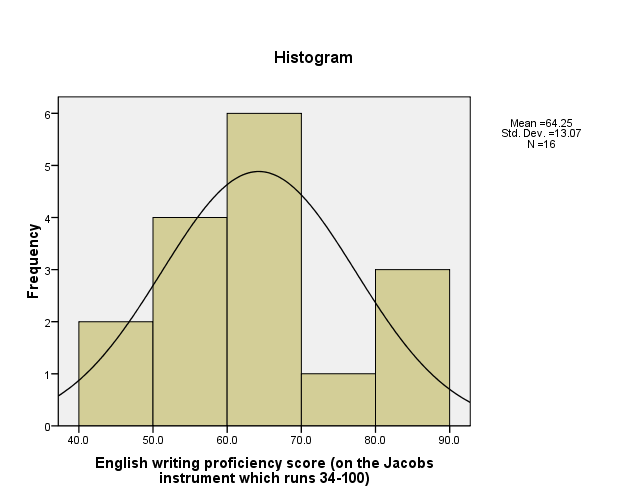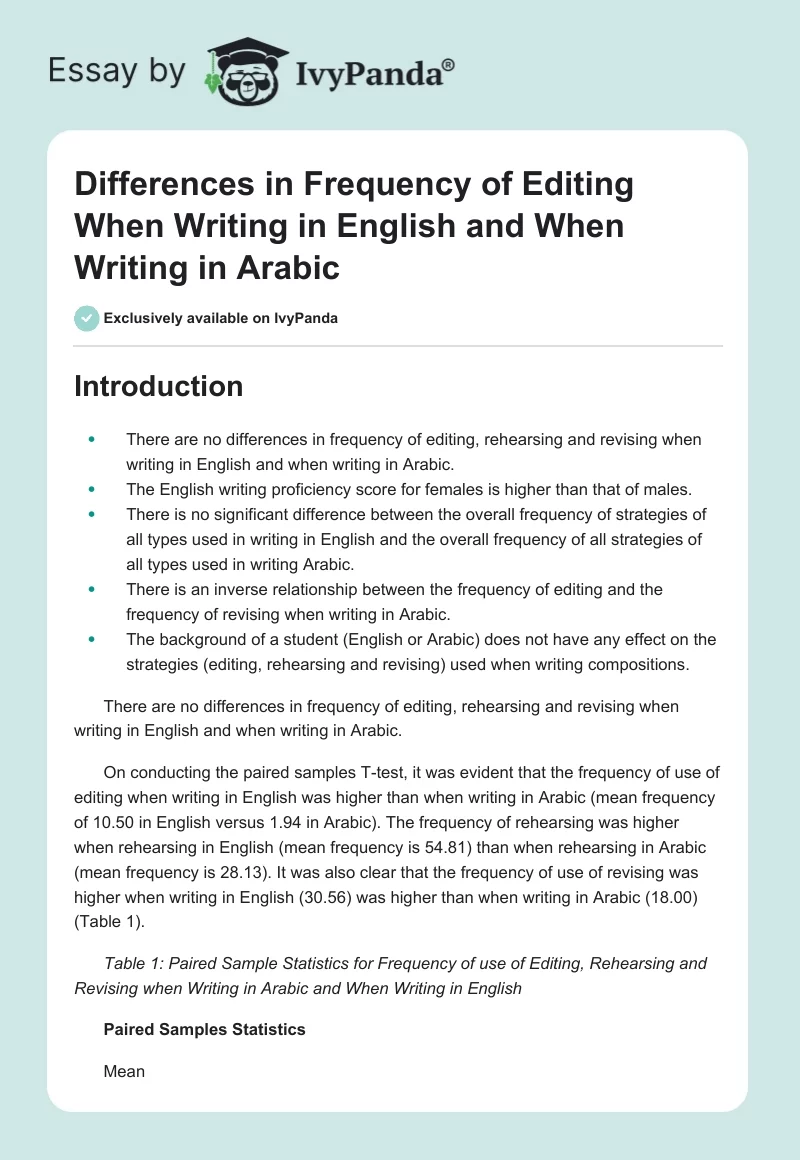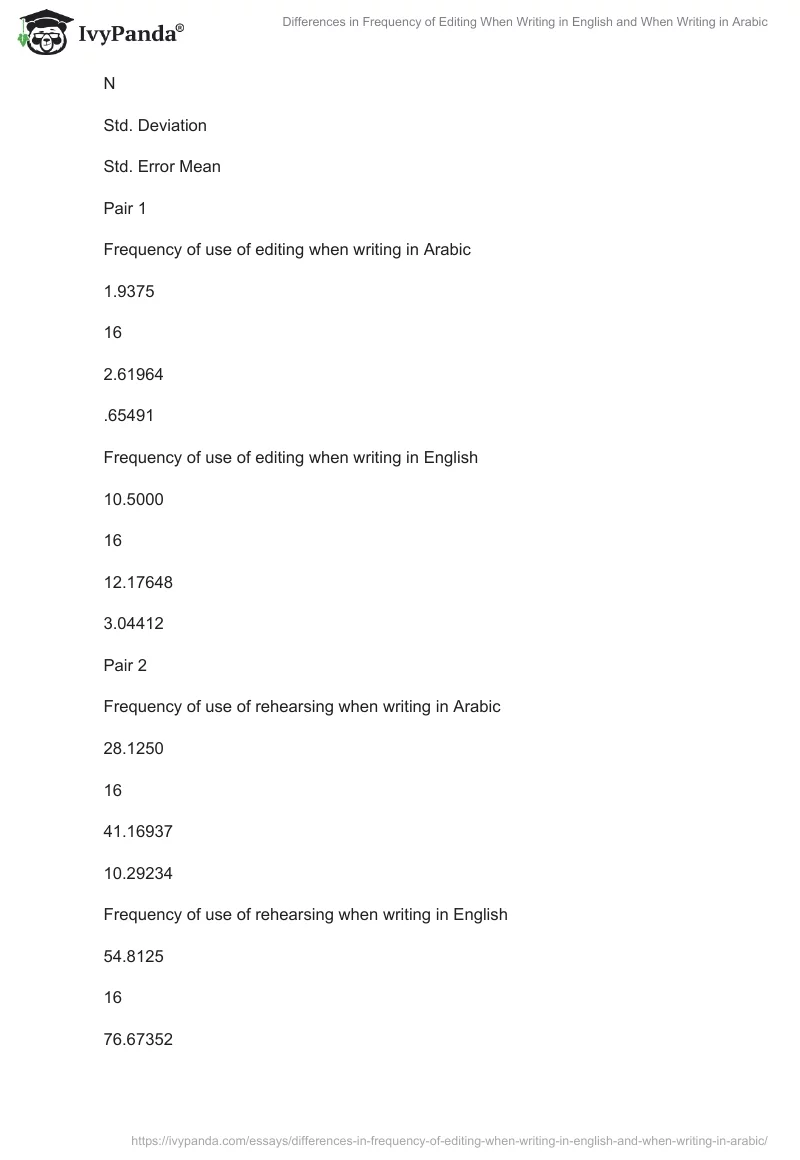Introduction
- There are no differences in frequency of editing, rehearsing and revising when writing in English and when writing in Arabic.
- The English writing proficiency score for females is higher than that of males.
- There is no significant difference between the overall frequency of strategies of all types used in writing in English and the overall frequency of all strategies of all types used in writing Arabic.
- There is an inverse relationship between the frequency of editing and the frequency of revising when writing in Arabic.
- The background of a student (English or Arabic) does not have any effect on the strategies (editing, rehearsing and revising) used when writing compositions.
There are no differences in frequency of editing, rehearsing and revising when writing in English and when writing in Arabic.
On conducting the paired samples T-test, it was evident that the frequency of use of editing when writing in English was higher than when writing in Arabic (mean frequency of 10.50 in English versus 1.94 in Arabic). The frequency of rehearsing was higher when rehearsing in English (mean frequency is 54.81) than when rehearsing in Arabic (mean frequency is 28.13). It was also clear that the frequency of use of revising was higher when writing in English (30.56) was higher than when writing in Arabic (18.00) (Table 1).
Table 1: Paired Sample Statistics for Frequency of use of Editing, Rehearsing and Revising when Writing in Arabic and When Writing in English
The paired samples correlations indicate that there was a weak and non significant correlation between frequency of use of editing when writing in Arabic and frequency of editing when writing in English (r =.331, p =.210). As such, the first part of the hypothesis that there are no differences in editing when writing in either English or Arabic has been supported. A strong positive correlation between frequency of use of rehearing when writing in Arabic and frequency of use of rehearsing when writing in English was however registered (r =.97, p =.001). In the same way, there was a strong positive and significant correlation between frequency of use of revising when writing in Arabic and frequency of use of revising when writing in English (r =.821, p =.001) (Table 2).
Table 2: Paired samples correlations for Frequency of use of Editing, Rehearsing and Revising when Writing in Arabic and When Writing in English
The paired samples t-test for frequency of use of editing when writing in Arabic was significantly different from the frequency of use of editing when writing in English (t (df , 15) = 2.959, 2-tailed significance =.01). There was a significant difference in frequency of use of rehearsing when writing in Arabic than when writing in English (t (df, 15) = 2.834, 2-tailed p value =.013). There was also a significant difference in the frequency of use of revising when writing in Arabic than when writing in English (t (df, 15) = 4.757, p =.001) (Table 3).
Table 3: Paired Samples Test for Frequency of use of Editing, Rehearsing and Revising when Writing in Arabic and When Writing in English
Since it is evident that there are differences in use of editing, rehearsing and revising when writing in both English and Arabic, the null hypothesis, there are no differences in frequency of editing, rehearsing and revising when writing in English and when writing in Arabic, is rejected. Instead the alternate hypothesis, there are differences in frequency of editing, rehearsing and revising when writing in English and when writing in Arabic, should prevail.
The English writing proficiency score for female students is higher than that of males
An ANOVA test conducted to identify whether there were any significant differences in English proficiency scores for males and females indicated that there was a non-significant difference in English proficiency scores between the two genders (F(1, 14 ) =.893, p >.005) (Table 6). This is despite the fact that males had a mean English proficiency score of 66.65, SD 14.43 whereas females had a mean score of 60.25, SD 10.34 (Table 4). The variability among the test scores was highest among male subjects as indicated by a SD of 14.42 against 10.22 for female subjects. The Levene’s test is not significant (significance =.279) (Table 5), indicating that the variances are the same and the assumption of ANOVA is not violated. The main ANOVA output table (Table 6) indicates that females did not register higher English proficiency scores compared to males (F (1, 14) =.893, p =.361). This is because the significance value is greater than.05.
Table 4: Descriptive Statistics for English Rating Proficiency Scores for Males and Females
Table 5: Test of Homogeneity of Variances for English Proficiency Score
Table 6: ANOVA Output for English Writing Proficiency Score
Descriptive statistics
This study involved sixteen participants of whom 62.5 percent (10) were males whereas 37.5 percent (6) were females (Table 7). It is therefore evident that male participants were more than female subjects. The mean English writing proficiency score (based on the Jacobs instrument scale of 34-100) was 64.25 with a standard deviation of 13.07. The minimum and the maximum scores were 41.5 and 88.0 respectively. The mean frequency of editing, rehearsing and revising when writing in Arabic was 1.936; SD 2.62, 28.125; SD 41.17 and 18.000; SD 17.55 respectively. On the other hand, the mean frequency of editing, rehearsing and revising when writing in English was 10.500; SD 12.18, 54.813; SD 76.67 and 30.563; SD 17.74 respectively. It is therefore clear that the frequency of editing when writing in Arabic is very low compared to frequency of editing when writing in English (1.936 in Arabic versus 10.500 in English). In the same manner, the frequency of rehearsing and revising is lower when writing in Arabic than when writing in English (28.125 times editing in Arabic versus 54.183 editing in English and 18.000 revising instances when writing in Arabic versus 30.563 revising instances when writing in English) (Table 8 ). The above findings are also confirmed by the finding that the overall frequency of all types of strategies used in writing English are very high (2.1119E2; SD 160.36) compared to the overall frequency of strategies used when writing in Arabic (1.1000E2; SD 80.71).
Table 7: Participant’s Gender (Frequencies and Percentages)
Table 8: Descriptive Statistics
Reliability Test for English Strategy Use (Cronbach’s Alpha)
It is notable that a Cronbach’s Alpha of.70 is taken to be appropriate as a measure of internal consistency in social science research (Field, 2009). As such, an alpha coefficient of.479 as indicated in Table 9 can be said to be a low coefficient. However since this test involves a small number of items (3 items), it is important to check the correlation between the items as well as the Cronbach’s value after deleting specific items to conclude whether there is reliability. According to Table 10, it is evident from the “Corrected Item-Total Correlation” column that there is a strong positive correlation (.878) between frequency of use of editing when writing in English and the combined score of frequency of use of rehearsing and revising when writing in English. In other words, frequency of use of editing when writing in English has a strong internal consistence with composite scores of editing and revising. A strong correlation also exists between frequency of rehearsing when writing in English and the combined score of frequency of editing and revising when writing in English. It has been suggested that a correlation that is less than.30 is weak and is not suitable for item-analysis (Griffin, 2009). In that case, the correlation between frequency of use of revising (.443) and the combined frequency of rehearsing and editing is still useful for this analysis despite being somewhat weak. In other words, frequency of use of revising is internally consistent with the combined frequency of use of editing and rehearsing when writing in English.
Table 9: Reliability Statistics for Frequency of Editing, Rehearsing and Revising While Writing In English
From the “Cronbach’s Alpha if item deleted” column, it is possible to identify which of the items (rehearsing, revising and editing) contributed to the total alpha of.479. If frequency of use of editing when writing in English is removed, the overall Cronbach’s alpha would drop to from.479 to.312, indicating that frequency of editing is useful and actually contributes to the overall Cronbach’s alpha value. Removing frequency of use of rehearsing also leads to an increase of the Cronbach’s value from.479 to.661, indicating that frequency of use of rehearsing is useful and contributes to overall Cronbach’s alpha. The Cronbach’s Alpha if item frequency of use of revising is removed would reduce only slightly from.479 to.420. Since the correlation between the frequency of revising and combined correlation of editing and rehearsing had earlier been termed as suitable for item analysis (since it is not less than.30 the frequency of use of revising should not be removed when calculating overall Cronbach’s alpha value. It is therefore conclusive that frequency of editing, rehearsing and revising are useful in measuring the variable ‘English strategic use’. This is despite the existence of a low alpha value of.479. Hersen (2004) explains that “all things being equal, shorter tests (less than about eight items) will yield lower alpha coefficients than longer tests” (p. 7). Hersen (2004) therefore concludes that “scales or tests with seven or less items may possess reliability, but it may not be reflected in the alpha coefficient” (p. 7). This is the case with the current analysis which involves three items only.
Table 10: Item-Total Statistics (Frequency of Editing, Rehearsing and Revising While Writing In English)
Writing proficiency (based on Jacobs scale)
On conducting a descriptive analysis of the data to find out the mean proficiency score, specifically on the English writing proficiency score (based on the Jacobs scale, 34-100), it was evident that a majority of the subjects had a score higher than 51, which defines the subjects as better in writing proficiency. The mean proficiency score was 64.25 (Table 8), implying that these subjects are definitely ‘better’ in writing proficiency than ‘poor’ in the Jacobs scale. Figure 1 below also illustrates a majority of the subjects had a score of between 60 and 70.

Possible ways of enhancing validity
Huitt and Kaeck (1999) mention that participants may perform differently if they discover or are aware that they are being observed, i.e. reacting to the setting of the experiment. It is therefore hoped that the researcher in this study controlled this by perhaps having the subjects be unaware that they were being observed, otherwise external validity may have been compromised. It is also hoped that the researcher considered differences in prior experiences in either of the languages, thus controlling for internal validity. This is because it has been established that internal validity is threatened by the unique experiences participants may have such that the experiences may act as independent variables and interfere with internal validity.
References
Field, A. P. (2009). Discovering statistics using SPSS. 6th edition. Thousand Oaks, CA: Sage Publications Ltd.
Griffin, B. W. (2009). Cronbach’s Alpha (measure of internal consistency). Web.
Huitt, W. and Kaeck, H. D. (1999). Internal and external validity: general issues. Web.


